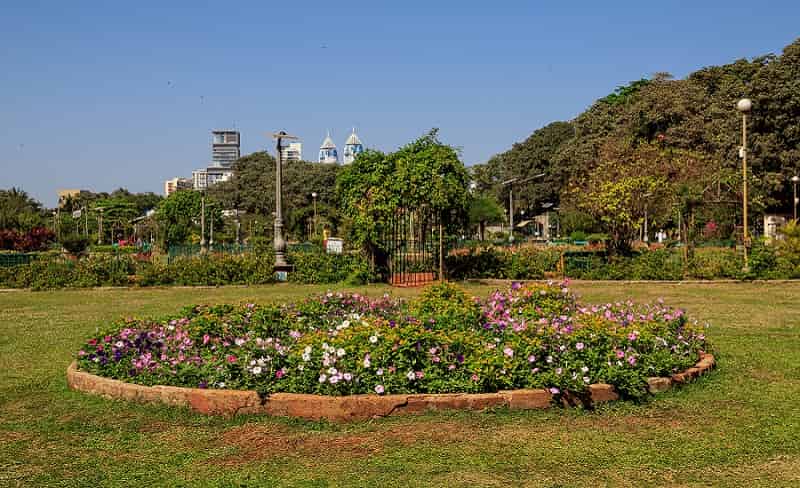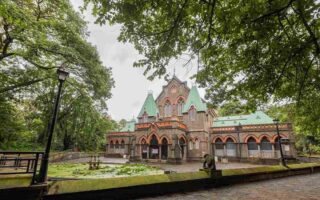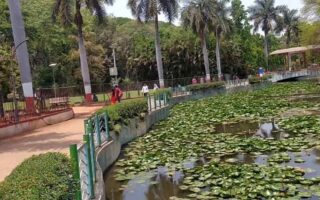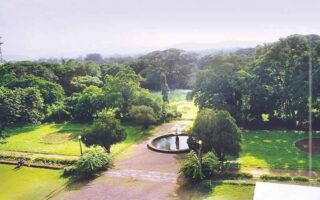- Hanging Gardens, also known as the Pherozeshah Mehta Gardens
- Initially built in the year 1880, with renovations done in 1921
- Located on a plot of the Malabar Hills in South Mumbai
- Major attractions are the hedgerows manicured in various animal shapes.
- Ideal time to visit – Mumbai is favorable to visitors from across the globe during anytime of the year.
- Timings of the Hanging Gardens – 5:00 AM to 9:00 PM
- Entry fee – No entry fee.
- Facilities like seats for resting, water for drinking and washrooms for answering nature’s calls are available here.
- Once in Mumbai, one can easily reach the Grant Road railway station, nearest to the Hanging Gardens, by local trains and board a BEST bus or cab to reach the gardens.
Mumbai is the administrative capital of Maharashtra and commercial capital of India. And as a general understanding, arts and commerce never get along well. Commerce is considered to be a boring subject as compared to arts. But, with Mumbai, this is not the case – not even in dreams. The city of Mumbai is as artistic and aesthetic as it scores commercially. And to prove this fact there are numerous of tourist attractions in the city that drive their imaginations to the wildest point of spirituality and bliss. The gardens in Mumbai play a major role in realizing this imagination. The only green conservation left in the city, besides the roadside plantations in response to the slogans of “Clean Mumbai Green Mumbai”, these gardens also serve as open rest rooms for visitors. They actually come here to spend a few hours of recreation and calmness.

The Hanging Gardens, Mumbai – Welcome!
There are two most popular gardens in Mumbai, and by coincident both of them are situated opposite each other, along the same lane. One is the Hanging Gardens, our topic of discussion in this page, while the other is Kamala Nehru Park, which we shall have a look at, later. The Hanging Gardens, in South Mumbai, also known as Pherozeshah Mehta Gardens pertaining to the initiator of its existence, are situated over the top of the apparent city, on the Malabar Hills in the west. This is the reason for the place being named so – the Hanging Gardens – because of the terraced location they have been fortunately destined to. These are called gardens, and not a single garden, pertaining to the collections of cubicles of smoothly carved and manicured patches of grass and plants.
The history of the Hanging Gardens in Mumbai narrates the cause of them being built up in the first place, in 1880. There are water reservoirs of 30 million gallons under the land where the present Hanging Gardens stand. The waters, before being supplied to the entire settlement for utilization, are cleaned in these reservoirs. There are also present Towers of Silence in the close vicinity of the garden area. To prevent the water from contaminating the Towers of Silence, while the cleaning process on goes, these Hanging Gardens were built. These gardens underwent renovation in 1921, and now they serve a totally different purpose, additionally.
The Make Up
The makeup of the gardens suits the location where it is situated, and looking at both, there’s just one word that comes to mind – sophisticated. The doorway to the gardens leads you to face the statue of Pherozeshah Mehta. A lot has changed in the gardens after he had led the construction, and even after the renovations, things weren’t as clean and well maintained as now. There are groups of smaller gardens in the main campus, each garden manicured with smooth beds of trimmed grass and gated with an entrance hedge. The creepers and climbers on these hedgerows make them look like special kinds of gates. Inside these gardens are more hedgerows that have shapes of diverse animals and birds like elephants, giraffes, horses, peacocks and more.
There are flower lanes along the fencing of each smaller garden that are bejeweled with beautiful, vibrantly colored flowers in between; the scene actually seems as if pearls, rubies and sapphires are engraved in the green ornaments of nature. There are penguins that say ‘USE ME’. Yes, I am talking about the penguin-like trash bins that are purposely made attractive for people to actually use them and not scatter waste all around the gardens. The Hanging Gardens in Mumbai are a true pleasure for everyone, from children to the aged.
What Magnetizes You Here?
There is nothing about the Hanging Gardens that can be ignored and that leave you without getting magnetized. But apart from everything else, there is something about the gardens that leaves a life-long impression in your mind – the panoramic view of the Arabian Sea during the sunset. From the height, where the Hanging Gardens actually hang, you can take pleasure in locking up in your eyes the vista of the sun setting against the horizons of the Arabian Sea. Wow! That was just unforgettable.
The Vicinity
There is more to add to the pride of the Hanging Gardens in Mumbai – the places environing it. There is the Girgaon Beach, popularly known as the Chaupati, in local terms, which is down the slope, at a short distance from the Hanging Gardens. The Beach is famous for its ‘Chaat’ – an array of sour and spicy dishes that have been melting the hearts of Mumbai since ages. Then, there is the most famous temple of ancient Mumbai, the Babulnath Temple, which is known for its wish fulfilling powers. Tourists generally visit the Hanging Gardens after enjoying at the beach and the temple. This is a sort of relaxation.
The Hanging Gardens in Mumbai is a true experience of nature, art and peacefulness – visit once and forever.
- Also Read: Popular Gardens of Maharashtra


